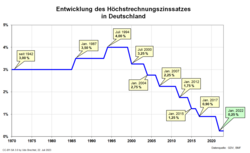Maximum interest rate
With the maximum technical interest rate , officially ceiling on the interest rate or maximum interest rate (often incorrectly as guaranteed interest referred) laying Federal Ministry of Finance determines the interest rate that insurers in calculating the actuarial reserves may use most. The maximum interest rate is set for:
- Life insurance by virtue of § 2 of the Premium Reserve Regulation , currently 0.9% (since January 1, 2017), and
- Health insurance based on the calculation regulation , currently 3.5%.
Determination of the maximum technical interest
The calculations of the maximum technical interest rate are initially based on the current yield published by the European Central Bank (ECB) on European AAA-rated government bonds with a ten-year term, from which the average yield over the past ten years is calculated. Assuming different interest rate developments, these average returns are projected into the future. The maximum actuarial interest rate could not exceed 60% of the average yield on these ten-year government bonds until 2015 ( Section 65 Insurance Supervision Act (VAG)). The maximum actuarial interest rate is proposed jointly by the German Actuarial Association and the Federal Financial Supervisory Authority . The interest rate is finally set by ordinance of the Federal Ministry of Finance . According to the law, the maximum technical interest rate is an upper limit that must not be exceeded. The VAG, which was revised in 2016, contains a comparable authorization to issue ordinances in Section 88 (3), but does not specify a calculation method because the previous European legal basis is no longer applicable. The legislator justifies the change with the reduced importance of the actuarial reserve after the introduction of Solvency II .
Purpose of the maximum discount rate
The maximum actuarial interest rate limits the discounting of the actuarial reserves and thus ensures a certain minimum amount of this accounting representation of the insurer's obligation. The interest rate used for the actuarial reserve when the contract was concluded, which may not exceed the maximum actuarial interest rate applicable at the time, may not be increased subsequently; It may only be reduced if the insurer can no longer generate this interest itself or if this is legally required. The maximum actuarial interest rate ensures that the insurer makes sufficient financial provision in the balance sheet and is therefore not immediately over-indebted, even in times with lower interest rates than when the contract was signed. Indirectly, however, the maximum technical interest rate for the actuarial reserve also forces the insurer to only consider future investment income in the calculation of the contributions to an extent that does not deviate too far from the maximum technical interest rate. Because according to Section 138 (1) VAG, the contributions must be calculated sufficiently to be able to finance the actuarial reserve. The maximum actuarial interest rate for the actuarial reserve is therefore also a preventive measure at optimistically calculated prices. In the European Union, however, there is no direct limit on the interest that may be used when calculating the contributions. This interest in the contributions is often referred to as guaranteed interest , but legally has nothing to do with the maximum technical interest or the interest on the actuarial reserve, even if in practice these interest rates often match.
Historical maximum technical interest
| Period | Maximum interest rate
(Capital life insurance) |
source |
|---|---|---|
| 1903-1922 | 3.50% | |
| 1923-1941 | 4.00% | |
| 01/1942 - 06/1986 | 3.00% | |
| 07/1986 - 06/1994 | 3.50% | |
| 07/1994 - 06/2000 | 4.00% | |
| 07/2000 - 12/2003 | 3.25% | |
| 01/2004 - 12/2006 | 2.75% | |
| 01/2007 - 12/2011 | 2.25% | |
| 01/2012 - 12/2014 | 1.75% | |
| 01/2015 - 12/2016 | 1.25% | |
| 01/2017 - | 0.90% |
Individual evidence
- ^ German Association of Actuaries , accessed on January 28, 2015.
- ↑ Explanation of the law on Section 88 (3) VAG, p. 301
- ^ German Association of Actuaries , accessed on February 16, 2017.
- ↑ BGBl. 2016 I p. 1231
Web links
- Premium reserve regulation
- Calculation Ordinance
- Lowering the maximum technical interest rate has little effect on the maturity benefit. General Association of the German Insurance Industry , February 22, 2011, accessed on February 5, 2017 .
